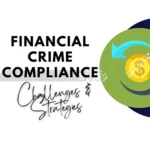Cryptocurrency or Convertible Virtual Currencies (CVCs) are increasingly used as a part of financial crimes like money laundering and terrorism financing as they provide greater anonymity, unrivaled privacy, and security unmatched by traditional banking systems. In this blog, you will learn how criminals leverage cryptocurrency for money laundering activities and the FinCEN recommendations to monitor cryptocurrency transactions for the financial services industry and meet global AML/CFT regulatory requirements.
While the use of cryptocurrency is accelerating exponentially, the overall numbers of cryptocurrency transactions related to financial crime are still limited when compared to cash and another form of transactions. However, cryptocurrencies are more vulnerable to financial crime activities and money laundering, which is a growing global concern with governments reporting a significant increase in the frequency of money laundering activities and other financial crimes involving cryptocurrency.
According to a report by blockchain data company Chainalysis, criminals moved over $14 billion in cryptocurrency to illicit addresses in 2021 over the year—up from 7.8 billion in 2020.
Cryptocurrency and Money Laundering
FATF perceives virtual currencies as potential anti-money laundering/countering financial terrorism (AML/CFT) risks due to a lack of clarity regarding the responsibility for AML/CFT compliance. According to FATF, cryptocurrencies and exchanges are designed to provide anonymity, avoid scrutiny by regulators and help criminals launder the proceeds. The money laundering process generally involves three stages,
- Placement: In this stage, illegal or dirty money is introduced into the financial systems by breaking large cash into smaller sums through activities such as smurfing, invoice fraud, offshore accounts, etc. For instance, a criminal can purchase cryptocurrencies as many crypto exchanges are unregulated and non-AML/CTF compliant
- Layering: The layering stage hides the true origin and separates the funds from the criminal source, thereby concealing the money trail.
- Integration: This is the final stage where the laundered funds mix with legitimate money earned legally and reaches a legitimate economy. These funds are then invested in real estate, luxury goods, business ventures, etc.
With anonymity provided by the convertible virtual currencies (CVCs) or cryptocurrencies and lack of regulations, criminals can easily avoid detection of money laundering by leveraging various strategies, such as:
- Crypto Mixing or tumbling: Criminals mix illicit and legal digital assets from several addresses together to increase anonymity and then move them to a new destination wallet address.
- Peer-to-Peer Networks: Criminals often use de-centralized Peer-to-Peer (P2P) crypto networks to transfer illicit funds to crypto ATMs, which allows them to purchase cryptocurrencies using debit cards. These exchanges also help users convert cryptocurrency into fiat (cash) currencies to purchase high-end items.
- Dark or Unregulated Exchanges: Dark Exchanges refer to unregulated cryptocurrency exchanges that don’t enforce anti-money laundering and KYC requirements.
- Gambling and Gaming websites: Many gambling and gaming sites often accept cryptocurrencies as payments, which money launderers use to buy in-game currency, virtual chips, credits, etc., and cash out. Once the money is transmitted to an individual’s account, it becomes legal or untainted money.
FinCEN Recommendations for Financial Institutions and Crypto-Exchanges
On May 09, 2019, Financial Crimes Enforcement Network (FinCEN) issued an advisory on illicit activity involving convertible virtual currency. The advisory provides detailed information on how criminals continue to exploit digital currency for money laundering and other illegal behavior and how financial institutions can report valuable information in reporting suspicious activities related to virtual currencies. This information includes,
- Cryptocurrency/virtual currency wallet addresses
- User account information
- Crypto transaction details—including transaction hashes with originator and recipient details
- Relevant transaction history
- Login information of the account holders (including IP addresses)
- Mobile device information, such as IMEI, network provider, etc.
- Analysis report of the customer’s public online profile and communications
Similarly, Bank Secrecy Act or BSA obligates cryptocurrency exchanges to implement an anti-money laundering program, register with FinCEN, maintain proper documentation, and file reports. These laws intend to regulate cryptocurrency fraud and financial crimes, such as financing terrorism and money laundering activities.
Counter the Financial Crime Risks Posed by Cryptocurrencies with Domain Expertise
The anonymity linked with cryptocurrency transactions encourages criminals to use the currencies to launder money or proceeds of crime and poses a stiff challenge to the regulators. However, cryptocurrency regulations and associated anti-money laundering (AML) frameworks are also evolving with the growing use of virtual currencies CVCs for financial crimes and other criminal activities, mandating banks and financial institutions to capture more information and leverage intelligent digital solutions to monitor the crypto transactions and provide all pertinent available information while filing a Suspicious Activity Report (SAR).
Anaptyss as a strategic partner helps banks and other financial institutions in strengthening their anti-money laundering and countering finance for terrorism (AML/CFT) capabilities with our domain expertise and intelligent digital solutions powered by AI and ML— ranging from case investigation to AML program audit/design and implementation. To learn more, you can refer to our guide to anti-money laundering in banking and finance.
Interested in more specific guidance for AML/CFT compliance? Write to us: info@anaptyss.com.


















